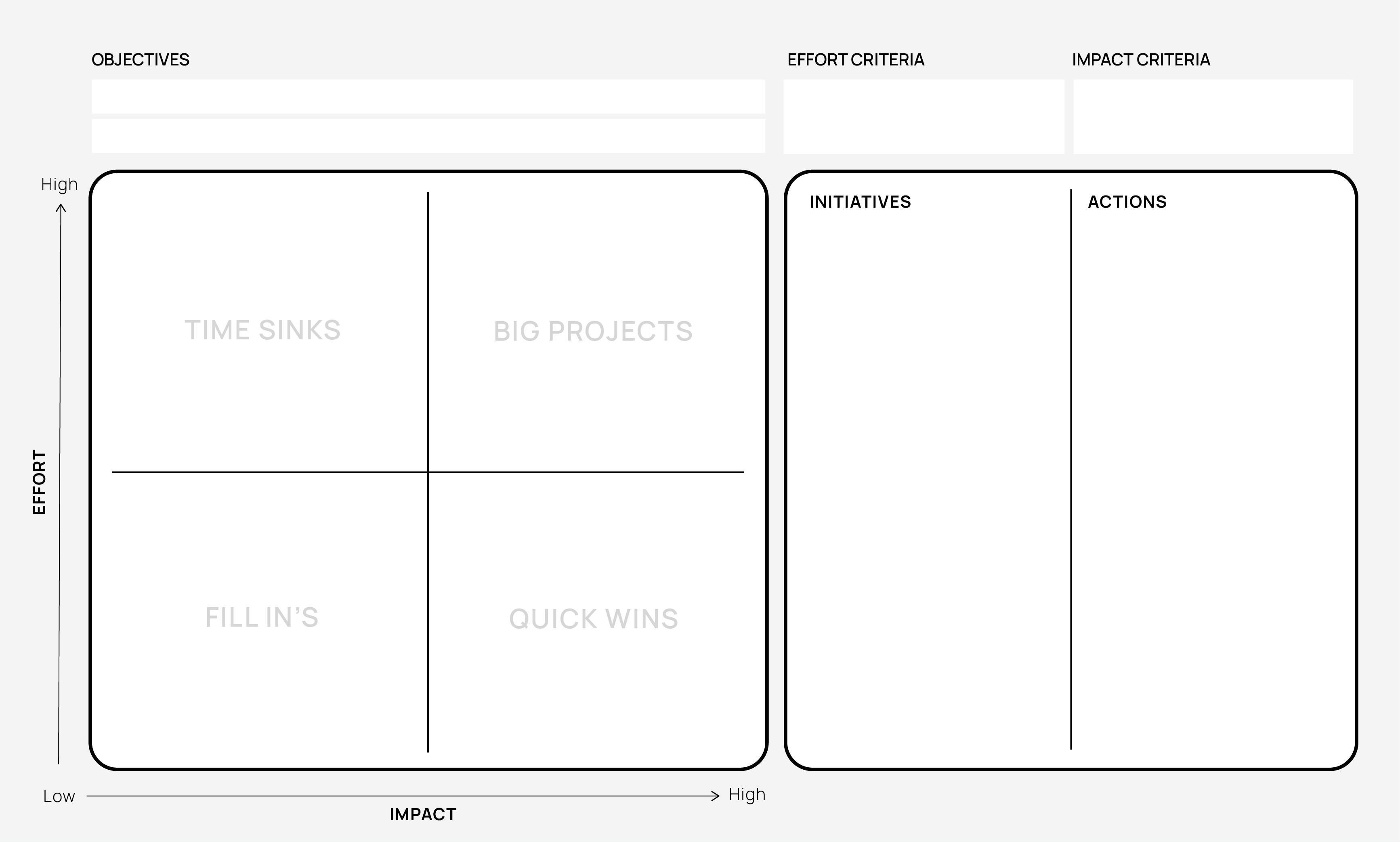Impact/ Effort Matrix
The Impact/Effort Matrix is a tool that helps organisations to decide what to focus on. It looks at how much good each task will do (impact) and how hard it will be to complete (effort).
The Impact/Effort Matrix has several key components:
Impact – The potential value or benefit of completing an initiative
Effort – The amount of resources, time, or work required to complete a task
Four Quadrants:
Quick Wins: High impact, low effort initiatives that provide significant value with minimal resource investment
Major Projects: High impact, high effort initiatives that offer substantial value but require significant time and resources
Fill-ins: Low impact, low effort initiatives that don’t significantly contribute to overall goals but can be done when there’s extra capacity
Time Sinks: Low impact, high effort initiatives to avoid or deprioritise due to poor return on investment
The results
- Clarity on where to focus efforts
- Improved team alignment

When to use it
Initiative prioritisation: When deciding which work should be prioritised
Business planning: When determining where to allocate resources
Product Development: When determining which features to develop first
Strengths
Clarifies priorities
Enhances focus
Provides a visual overview
Weaknesses
May oversimplify complex projects
Lacks consideration of risks
Impact and effort can be subjective
How to use it?
What do I need to start?
- Insights on the vision and goals of the organisation
- A list of initiatives to be prioritised
- An understanding of available resources
How to use it?
Who to involve?
Impact/Effort Matrix can be done alone or with a team. Consider involving:
- People who have an understanding of the overall business strategy
- People who can provide insights into the required resources and effort
- People who can provide insights into the likely impact
Step by step
1
Clarify the goals of the organisation
Clearly define and articulate the organisation’s objectives and priorities. Ask questions like:
- What are our strategic goals?
- What outcomes are we trying to achieve?
- What defines success for our organisation?
2
Define criteria
Establish criteria for measuring impact and effort.
- For impact this could be customer satisfaction, revenue impact or return on investment.
- For effort this could be the resource effort or the financial investment required.
Ensure the criteria aligns with organisational objectives.
3
List initiatives
Compile a list of current and potential initiatives. For each item:
Evaluate impact – Assess the impact based on the defined criteria. Ask questions like:
- How much will this initiative help us achieve our objectives?
- How much value will this create?
- What’s the potential return on investment?
Evaluate effort – Estimate the effort required for each initiative based on the defined criteria. Ask questions like:
- What resources are needed?
- Do we have the resources to do this right now?
4
Plot the matrix
Place each initiative on the Impact/Effort Matrix.
Review and consider if all items look right relative to each other, and make adjustments as needed. Ask questions like:
- Where does each initiative fall on the matrix?
- Are there any surprising placements?
- Does the placement of each initiative align well with organisational objectives and priorities?
5
Review the matrix and prioritise initiatives
Quick Wins: Focus on ‘High Impact, Low Effort’ initiatives first. These offer quick, impactful wins with minimal effort and should generally be prioritised.
Big Projects: Next, consider ‘High Impact, High Effort’ initiatives. These are often strategically important but require more resources. Identify the most impactful initiatives, recognising that only a few can be tackled due to the high effort required.
Low Impact, Low Effort: These initiatives can be addressed during spare time or as a break from more intense work. Generally, they should not be prioritised.
Time Sinks: Avoid new initiatives in ‘Low Impact, High Effort’. If initiatives already exist and are assessed as time sinks, consider closing the initiatives.
Ask questions like:
- Which initiatives should we tackle first?
- Can any high-effort initiatives be broken down into smaller initiatives?
- Are there any dependencies that affect the prioritisation?
- Do the prioritised initiatives align with our overall vision, strategy and objectives?
6
Discuss and validate
Review the matrix with key stakeholders and adjust as needed.
7
Develop action plans
Define actions for executing the prioritised initiatives
Consider drafting a Project Initiation Document (PID) or 1-page Business Case for each prioritised initiative. Ask questions like:
- What are the next steps for each priority initiative?
- Who will be responsible for each initiative?
- What timelines should be set?